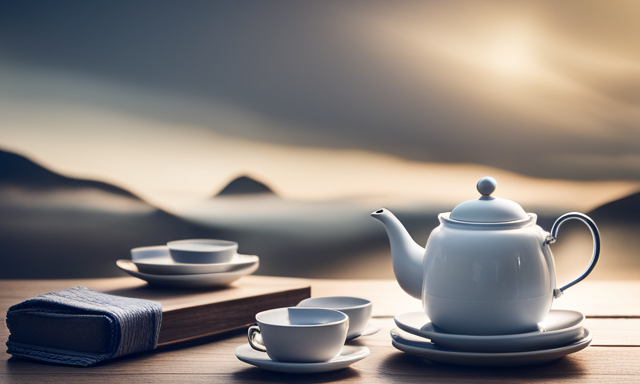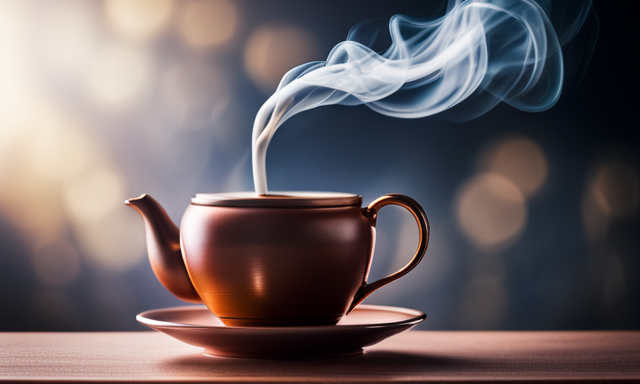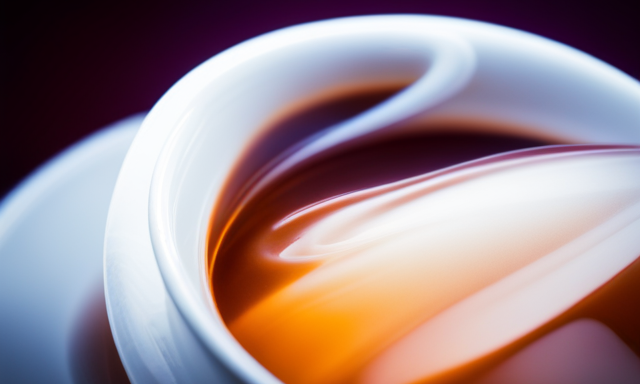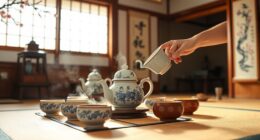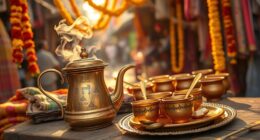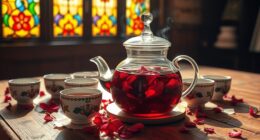Have you ever wondered what your favorite tea says about you?
Well, let’s take a closer look at oolong tea and its profound connection to our personalities.
Picture this: you’re sitting in a cozy cafe, enjoying a steaming cup of oolong tea, its delicate aroma wafting through the air.
As you take a sip, you can’t help but notice the intricate flavors dancing on your taste buds.
That moment, my friend, reveals more about you than you may realize.
Oolong tea, with its rich history and diverse range of flavors, has the power to reflect our unique preferences, characteristics, and even our state of mind.
Whether you find yourself gravitating towards the delicate and floral varieties or the bold and robust ones, your choice of oolong tea reveals something deeper about who you are.
So, join me on this journey as we explore the fascinating world of oolong tea and discover the hidden messages it holds for us.
Key Takeaways
- Oolong tea originated in China and gained popularity worldwide due to its diverse flavors and health benefits.
- Different types of oolong tea have distinct flavor profiles, ranging from fresh and grassy to creamy and buttery.
- Delicate and floral oolong teas reflect sophistication and promote relaxation, while bold and robust oolong teas show an adventurous spirit.
- Oolong tea offers numerous health benefits, such as aiding in weight loss, improving digestion, and strengthening the immune system.
The History and Origins of Oolong Tea
If you’re curious about the history and origins of oolong tea, you’re in for a fascinating journey through the rich heritage of this delightful beverage.
Oolong tea, known for its unique flavor and aroma, has a long-standing tradition that dates back centuries. Originating in China, oolong tea is produced through a meticulous process that involves the cultivation and production methods specific to this tea variety.
The leaves are carefully plucked and then withered in the sun before being oxidized and partially fermented. This intricate process gives oolong tea its distinct characteristics and sets it apart from other teas.
Over time, oolong tea has gained popularity not only in China but also in many other countries around the world. Its diverse flavor profiles and health benefits have contributed to its widespread appeal.
Now, let’s explore the flavor profiles of different types of oolong tea.
The Flavor Profiles of Different Types of Oolong Tea
When you drink oolong tea, you’ll taste a wide range of flavor profiles. Oolong tea is known for its unique aromas and the different oxidation levels that contribute to its distinct taste. The flavor profiles of oolong tea can vary from light and floral to rich and roasted. To give you a better understanding, here is a comparison table of the flavor profiles of different types of oolong tea:
| Type of Oolong Tea | Flavor Profile |
|---|---|
| Green Oolong | Fresh, grassy |
| Jade Oolong | Light, floral |
| Milk Oolong | Creamy, buttery |
| Roasted Oolong | Nutty, toasty |
| Tie Guan Yin | Floral, fruity |
Each type of oolong tea offers a unique taste experience, allowing you to explore the diverse world of tea. Now, let’s dive into delicate and floral oolong teas: what they say about you.
Delicate and Floral Oolong Teas: What They Say About You
Indulging in delicate and floral oolong teas allows you to embrace your sophisticated side and savor the enchanting essence that dances on your palate.
These teas are known for their exquisite floral aroma, adding a touch of elegance to every sip. The delicate and nuanced flavors reflect a refined taste and an appreciation for the finer things in life.
Not only do these teas offer a delightful sensory experience, but they also come with numerous health benefits. They are rich in antioxidants, helping fight off free radicals and boost the immune system. Additionally, delicate and floral oolong teas are known to improve digestion and promote relaxation.
Transitioning into the subsequent section about ‘bold and robust oolong teas: what they say about you’, it’s time to explore a whole new dimension of tea appreciation.
Bold and Robust Oolong Teas: What They Say About You
Embracing the bold and robust flavors of oolong teas adds a touch of adventurous spirit to your tea journey. These teas are known for their rich and complex profiles that can range from fruity and nutty to earthy and toasty.
To brew them perfectly, start by using water that is heated to around 190-200°F, as boiling water can scorch the leaves and result in a bitter taste. Steep the leaves for 3-5 minutes, or longer if you prefer a stronger flavor.
For beginners, I recommend trying Tie Guan Yin or Da Hong Pao, two popular oolong teas that strike a balance between boldness and approachability. These teas will awaken your senses and leave you wanting more.
Now, let’s delve into the health benefits of oolong tea.
Oolong Tea and Health Benefits
Sipping on a cup of this delightful brew is like taking a refreshing stroll through a fragrant orchard, with each sip offering a vibrant burst of health benefits. Oolong tea is not only a delicious beverage, but it also has several advantages for your well-being. Here are three reasons why oolong tea is a fantastic choice for your health:
-
Oolong tea and weight loss: Studies have shown that oolong tea can help boost metabolism and increase fat burning. It contains polyphenols that aid in calorie expenditure, making it an excellent addition to your weight loss journey.
-
Oolong tea and digestion: This tea has been known to improve digestion and relieve digestive issues such as bloating and constipation. It contains enzymes that facilitate the breakdown of food, promoting a healthy digestive system.
-
Oolong tea and overall health: Oolong tea is rich in antioxidants, which can help reduce the risk of chronic diseases and strengthen the immune system. It also contains vitamins and minerals that support overall well-being.
With its numerous health benefits, oolong tea is not just a delightful beverage, but also a wise choice for your body.
Now, let’s explore the ritual of brewing oolong tea.
The Ritual of Brewing Oolong Tea
Immerse yourself in the ancient art of brewing Oolong tea. As the delicate leaves unfurl in hot water, they release their captivating aroma and vibrant flavors.
The art of brewing Oolong tea is a true testament to the rich history and cultural significance of this beloved beverage. In Oolong tea culture, tea ceremonies hold great importance. They symbolize the mindfulness and appreciation of the tea-drinking experience.
Each step of the brewing process is carefully executed. From selecting the finest leaves to controlling the temperature and steeping time. The ritual of brewing Oolong tea not only produces a delicious and satisfying cup, but it also allows one to fully engage with the present moment. It fosters a sense of tranquility and mindfulness.
Transitioning into the subsequent section about Oolong tea and mindfulness, we will explore how this ancient practice can bring about a deeper sense of self-awareness and inner peace.
Oolong Tea and Mindfulness
After exploring the ritual of brewing Oolong tea, I am excited to delve into the connection between Oolong tea and mindfulness.
As a tea enthusiast, I have discovered that Oolong tea has a unique ability to promote a sense of calm and relaxation, making it an ideal companion for a daily meditation practice.
The combination of the tea’s soothing aroma and the act of mindfully preparing and savoring each sip creates a tranquil experience that aids in stress relief.
Oolong tea has become an integral part of my meditation routine, allowing me to fully immerse myself in the present moment and cultivate a deep sense of mindfulness.
By incorporating Oolong tea into my daily practice, I have found a powerful tool for achieving inner peace and balance.
Transitioning into the next section on Oolong tea’s cultural significance, we will explore its rich history and traditional significance in various cultures.
Oolong Tea and Cultural Significance
Discover the captivating cultural significance of Oolong tea as it weaves its way through various traditions, captivating the senses and connecting communities.
Oolong tea is deeply intertwined with cultural traditions, especially in East Asia. In China, it is common to hold oolong tea ceremonies, where the brewing process is meticulously executed with precision and grace. These ceremonies symbolize harmony, respect, and the appreciation of nature.
The art of serving and enjoying oolong tea has been passed down through generations, making it a cherished part of cultural heritage. Each sip of this exquisite tea is a sensory experience, engaging all the senses and providing a moment of tranquility and reflection.
Oolong tea brings people together, fostering a sense of community and shared appreciation for the rich cultural traditions it represents. As we explore the cultural significance of oolong tea, we can also delve into the delightful world of pairing it with food, experiencing the perfect harmony of flavors.
Pairing Oolong Tea with Food
Enhance your culinary experience by exploring the art of pairing Oolong tea with delectable dishes, creating a symphony of flavors that dance on your palate. Oolong tea’s unique characteristics make it a versatile companion for a variety of desserts.
Its floral and fruity notes beautifully complement sweet treats like peach cobbler or lemon tart, adding a touch of sophistication to the dining experience. Additionally, Oolong tea is known for its potential weight loss benefits. Its natural polyphenols can help boost metabolism and aid in digestion, making it a guilt-free choice when indulging in desserts.
So, not only can you satisfy your sweet tooth, but you can also support your wellness goals. Now, let’s delve into exploring different Oolong tea varieties and discover the nuances they bring to the table.
Exploring Different Oolong Tea Varieties
Delving into the realm of Oolong tea varieties reveals a rich tapestry of flavors and aromas waiting to be explored.
Learning Oolong tea brewing techniques opens up a world of possibilities in creating the perfect cup.
Each variety offers a unique experience, from the floral notes of Tie Guan Yin to the roasted flavors of Da Hong Pao.
The process of exploring different Oolong tea blends allows me to discover my personal preferences and expand my palate.
With its diverse range of flavors, Oolong tea caters to every taste preference, whether you enjoy a lighter, more delicate brew or a robust, full-bodied infusion.
The art of brewing and savoring Oolong tea is a journey of discovery, one that continually captivates and delights me.
Frequently Asked Questions
How much caffeine does oolong tea contain?
Oolong tea contains a moderate amount of caffeine. It offers numerous health benefits, including improving digestion, boosting metabolism, and reducing the risk of heart disease.
Can oolong tea be brewed multiple times?
Yes, oolong tea can be brewed multiple times. Reusing the leaves allows for the full extraction of flavors and the potential health benefits, such as increased antioxidants. Each brew reveals different flavor profiles, creating a unique tasting experience.
What is the best temperature to brew oolong tea?
Brewing oolong tea at 185-205°F brings out its best flavor profiles. The best brewing methods include steeping the leaves multiple times to fully appreciate the tea’s complexity and depth.
Are there any side effects of drinking oolong tea?
Drinking oolong tea may have potential risks, including digestive issues and caffeine sensitivity. However, when consumed in moderation, there haven’t been significant long-term effects reported.
Is oolong tea suitable for people with certain dietary restrictions, such as gluten-free or vegan diets?
Oolong tea is suitable for those with dietary restrictions like gluten-free or vegan diets. Its antioxidants and polyphenols aid in weight loss and regulating blood sugar levels. Soothing and energizing, oolong tea is a perfect addition to any healthy lifestyle.
Conclusion
After delving into the fascinating world of oolong tea, I am left enchanted by its rich history, diverse flavors, and numerous health benefits. The delicate and floral varieties transport me to a serene garden, while the bold and robust ones awaken my senses with their deep complexity.
Oolong tea, with its mindful preparation and cultural significance, is not just a beverage but a journey of the senses. So next time you sip on your favorite oolong tea, allow it to transport you to a world of taste, tradition, and tranquility.


